Welcome to the fascinating world of Indian cuisine! Get ready to embark on a culinary journey filled with mouthwatering flavors and delightful surprises. Indian cuisine is like a kaleidoscope of tastes, reflecting the incredible diversity of this vibrant country.
You see, India is not just a land of one type of curry or one style of cooking. Oh no! It’s a treasure trove of culinary wonders, with each region boasting its own unique specialties and flavor profiles.
So, why this guide, you ask? Well, its purpose is simple yet exciting! We’re here to give you a fantastic overview of Indian cuisine and introduce you to its incredible array of tastes.
Regional Varieties
Northern Cuisine
When it comes to Northern Indian cuisine, prepare yourself for a delightful affair. Northern cuisine revolves around the abundant use of dairy products and wheat-based bread. The North is famous for its creamy and indulgent dishes that incorporate rich flavors. Picture yourself savoring a plate of butter chicken, succulent pieces of chicken simmered in a luscious tomato-based gravy enriched with butter and cream. Your taste buds will also dance with joy as you take a bite of fragrant biryani, a flavorful rice dish cooked with aromatic spices, tender meat, or vegetables. And let’s not forget about the mouthwatering kebabs. Whether it’s the juicy seekh kebabs made from minced meat or the succulent tandoori chicken marinated in a blend of yogurt and spices and cooked in a traditional clay oven called a tandoor.
In a nutshell, Northern Indian cuisine is a celebration of rich flavors, creamy textures, and hearty dishes. With its iconic dishes like butter chicken, biryani, and kebabs, the Northern region offers a delectable journey into the heart of Indian cuisine. And the best part? You can savor these delights with some freshly baked naan or roti, the wheat-based bread that accompanies these dishes perfectly. So get ready to indulge in the flavors of the North and experience the culinary wonders it has to offer.
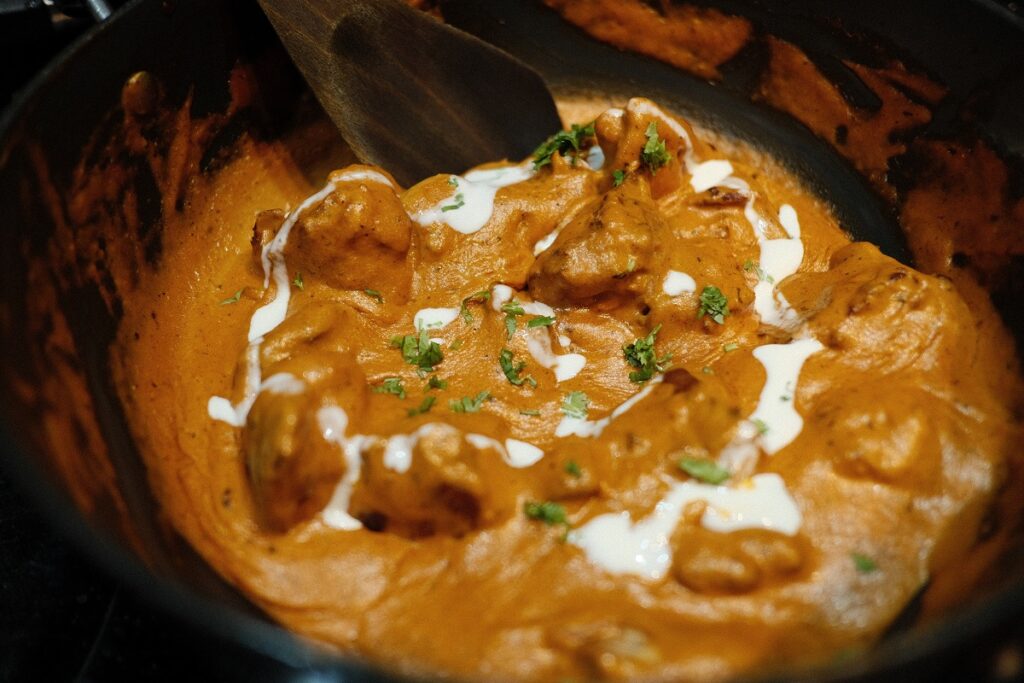
Southern Cuisine
Southern Indian cuisine is characterized by the prominent influence of rice, coconut, and a distinct array of spices, such as mustard seeds and curry leaves. Rice takes center stage as a staple ingredient in Southern India, serving as the foundation for numerous dishes. The use of coconut adds a delightful sweetness and creamy texture to curries and chutneys. Meanwhile, the culinary landscape of the region is enhanced by the aromatic presence of spices like mustard seeds. They provide a subtle pungency, and curry leaves, are known for their distinct earthy and citrusy notes.
Among the diverse array of dishes in Southern Indian cuisine, a few stand out as beloved classics. Dosas, for instance, are thin and crispy fermented crepes made from a mixture of rice and lentils. Served alongside coconut chutney and sambar—a lentil-based soup enriched with vegetables and an assortment of spices. Dosas offers a satisfying combination of flavors and textures. Another popular item is idli, soft and fluffy steamed rice cakes that are often enjoyed with spicy chutney or sambar. In addition to these breakfast delights, Southern Indian cuisine features an array of vegetable and meat curries. Such as avial—a mixed vegetable curry cooked in coconut and yogurt. And Chettinad chicken, a spicy and aromatic chicken curry hailing from the Chettinad region.
The combination of dosas, idlis, and the rich flavors of sambar exemplify the essence of Southern Indian cuisine. It offers a taste of the coastal regions that is both comforting and captivating.
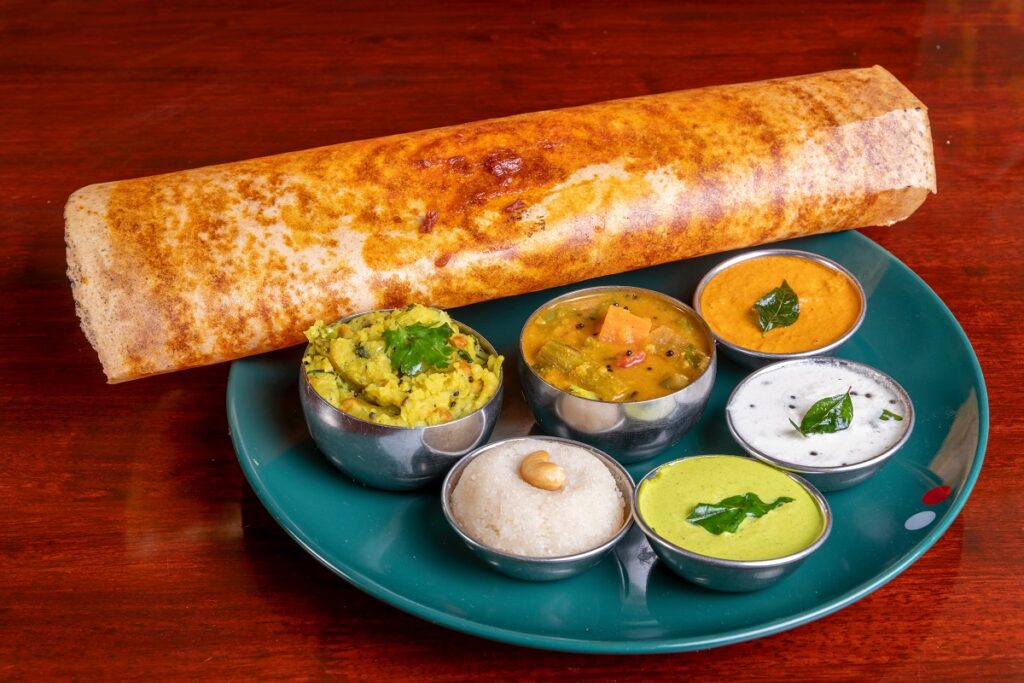
Eastern Cuisine
Eastern Indian cuisine is a culinary treasure trove that showcases a unique blend of flavors influenced by fish, mustard oil, and the distinct spices of the Bengali region. Given the abundance of rivers and coastal areas in the East, fish holds a special place in the cuisine. Mustard oil, with its strong and pungent flavor, is a commonly used cooking medium that adds a distinct character to Eastern Indian cuisine. Furthermore, the region’s love affair with spices, particularly the signature Bengali spice blend known as panch phoron, elevates the flavors to new heights.
Let’s explore some of the iconic dishes from Eastern Indian cuisine. Macher jhol, a popular fish curry, showcases the mastery of blending spices with fish to create a flavorful and aromatic dish. Another delicacy is shorshe ilish, where hilsa fish is marinated and cooked in a mustard paste, creating a tangy and richly spiced preparation that is highly sought after. To satisfy your sweet tooth, Eastern India offers sandesh. Its a delectable dessert made from fresh cottage cheese (chhena) and sweetened with sugar, flavored with ingredients like cardamom and saffron.
With dishes like macher jhol, shorshe ilish, and the delightful sandesh, Eastern Indian cuisine invites you to embark on a flavorful journey that showcases the region’s rich culinary heritage and love for fish, spices, and a touch of sweetness. Get ready to savor the tantalizing tastes of Eastern India and discover the magic of its vibrant cuisine.
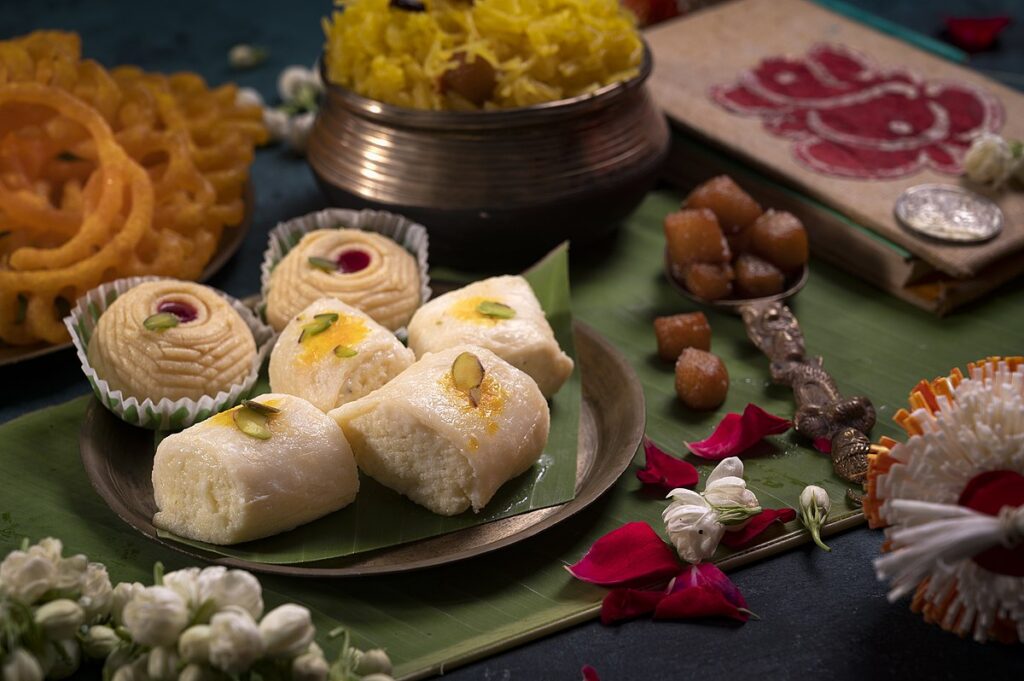
Western Cuisine
With its long coastline along the Arabian Sea, seafood takes center stage in this region’s gastronomy. From succulent prawns to flavorful fish, the use of fresh seafood is a defining element of Western Indian cuisine. Additionally, the cuisine incorporates the richness of coconuts. They are used in various forms such as grated, milk, or oil, to impart a creamy and tropical essence to many dishes. Spices like kokum and tamarind add a tangy and sour note, balancing the flavors and enhancing the overall taste profile.
When it comes to popular dishes from Western Indian cuisine, a few notable ones stand out. Vindaloo, a dish with Portuguese origins, features marinated meat, typically pork or chicken. They are cooked with a tangy and fiery blend of vinegar, red chilies, and spices. Goan fish curry is another highlight, where fresh fish is simmered in a rich and flavorful coconut-based gravy, infused with aromatic spices. Dhokla, a savory steamed cake is made from fermented rice and lentil batter. It is a popular snack or breakfast item known for its light and fluffy texture, accompanied by tangy chutneys.
Western Indian cuisine’s emphasis on seafood, coconuts, and the vibrant flavors of spices like kokum and tamarind creates a culinary journey that is both indulgent and refreshing. With dishes like vindaloo, goan fish curry, and the delightful dhokla, Western Indian cuisine showcases the region’s coastal influences.
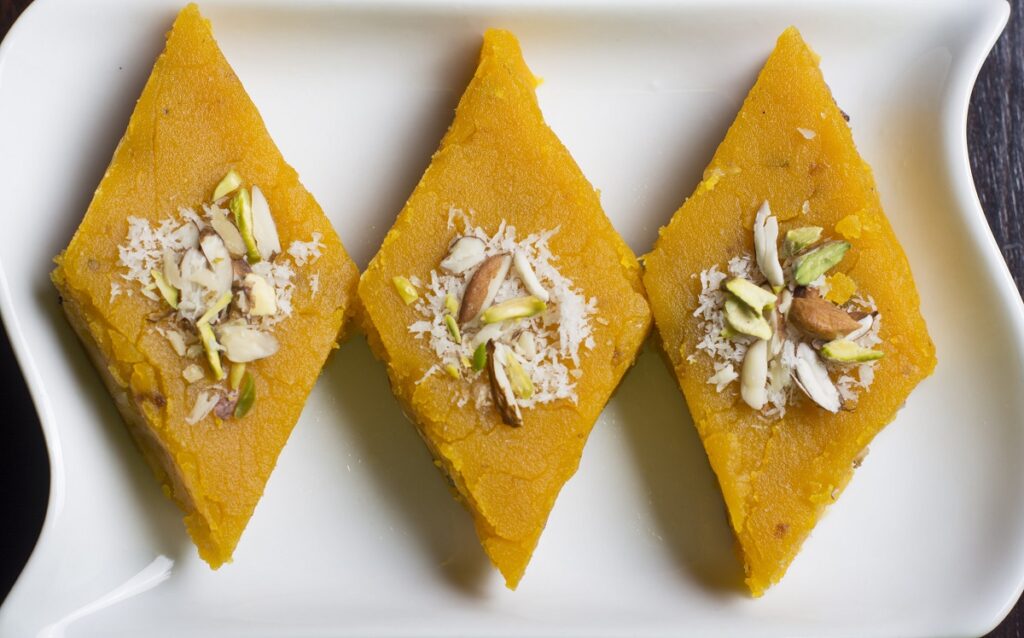
Essential Ingredients and Spices
Key ingredients used in Indian cuisine
When it comes to Indian cuisine, a multitude of essential ingredients and spices form the backbone of its diverse flavors. Lentils, rice, and an array of grains play a vital role in Indian cooking. From dal, a comforting lentil stew, to biryani, a fragrant rice dish, these staples form the core of Indian meals. Additionally, the vibrant world of Indian cuisine embraces the richness of vegetables, fruits, and herbs. Fresh produce such as tomatoes, potatoes, spinach, and cilantro add depth and variety to dishes. Furthermore, aromatic herbs like coriander, mint, and curry leave infuse their unique flavors.
Dairy products also hold a significant place in Indian cuisine. Ghee, a clarified butter, is widely used for cooking and adds richness and nuttiness to dishes. Yogurt provides a cooling and tangy element, often served as a side dish or used in marinades and sauces. Paneer, a fresh cheese made from cow’s milk, adds a delightful creaminess to curries and is a popular vegetarian protein option. These dairy products lend a distinct character to Indian dishes, enhancing their flavors and textures.
The Role of Spices in Indian Cooking
Spices are an integral part of Indian cooking, adding depth, complexity, and a burst of flavors to dishes. Commonly used spices such as turmeric, cumin, coriander, and cardamom play key roles in enhancing the taste profile of Indian cuisine. Turmeric lends a vibrant yellow hue and earthy flavor, while cumin provides a warm and nutty undertone. Coriander adds freshness and a citrusy note, while cardamom brings a hint of floral and aromatic sweetness. These spices, among others, create a symphony of flavors that tantalize the senses and distinguish Indian dishes.
In Indian cooking, the use of spices goes beyond adding heat. It’s about achieving a delicate balance between spice and flavor. Indian cuisine embraces the concept of “masala,” a combination of spices that are skillfully blended to achieve a harmonious taste. Spice blends like garam masala, a fragrant mixture of ground spices, and curry powder, a versatile blend of various spices, are used to elevate dishes to new heights. These spice blends add complexity and richness, imparting layers of flavors that make Indian cuisine so captivating and unique.
In essence, spices are the heart and soul of Indian cooking, infusing dishes with their distinct aromas, flavors, and colors. From turmeric and cumin to coriander and cardamom. The artful use of spices in Indian cuisine creates a symphony of tastes that is both vibrant and balanced. The carefully crafted spice blends like garam masala and curry powder further enhance the culinary experience.
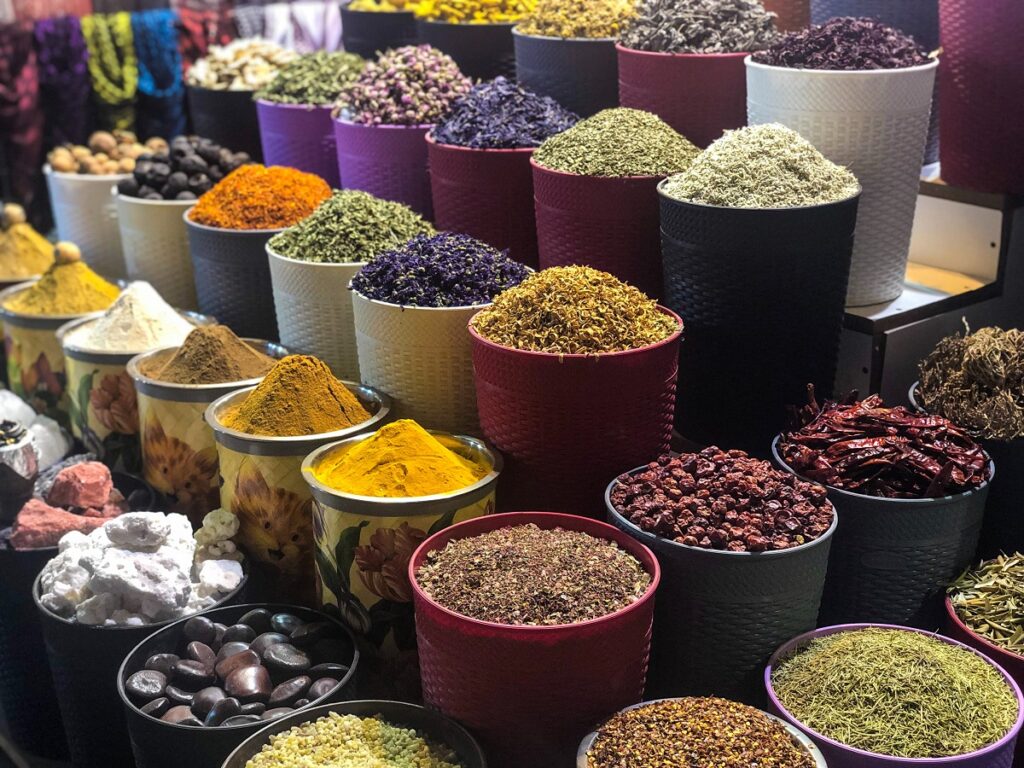
Signature Dishes
Appetizers and Street Food
Indian cuisine is renowned for its vibrant and diverse array of appetizers and street food. Popular streets food items like samosas, deep-fried pastry pockets filled with savory fillings, pakoras, crispy fritters made with various vegetables or lentils, and chaat, a delightful medley of savory snacks topped with chutneys and spices, are beloved across the country.
Each region in India also boasts its own unique street food specialties. In Mumbai, you’ll find the iconic vada pav, a spicy potato fritter sandwiched in a soft bun. While the streets of Delhi are famous for pani puri, crispy hollow puris filled with spiced tangy water. Kolkata is renowned for its kathi rolls, where succulent fillings like grilled meats or paneer are wrapped in parathas. These signature street food items offer a burst of flavors, textures, and culinary creativity. They are the essence of India’s street food culture and delighting taste buds everywhere.
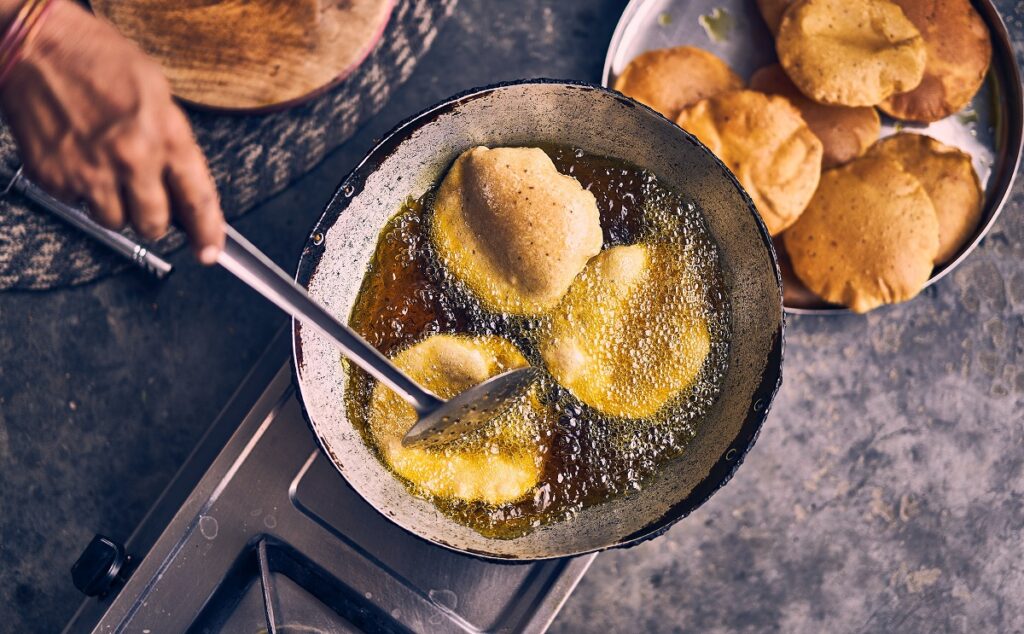
Main Course
The main course of Indian cuisine showcases a delightful array of both vegetarian and non-vegetarian dishes. Vegetarian options abound, with classics like chana masala, a hearty chickpea curry bursting with spices, palak paneer, a creamy spinach curry with cubes of soft paneer cheese, and baingan bharta, a smoky eggplant dish cooked with tomatoes and spices. These vegetarian delicacies highlight the versatility of Indian cuisine and provide a satisfying and flavorful dining experience.
For non-vegetarian enthusiasts, the main course offers an equally impressive selection. Chicken tikka masala, a popular dish worldwide, features succulent grilled chicken in a rich and spiced tomato-based gravy. Rogan josh, a flavorful Kashmiri lamb curry cooked with a blend of aromatic spices, showcases the regional specialties of North India. And let’s not forget the coastal delights, with fish curry stealing the spotlight, where fresh fish is simmered in a tangy and coconut-infused gravy. These non-vegetarian dishes reflect the culinary diversity of India and offer a delightful feast for the senses.
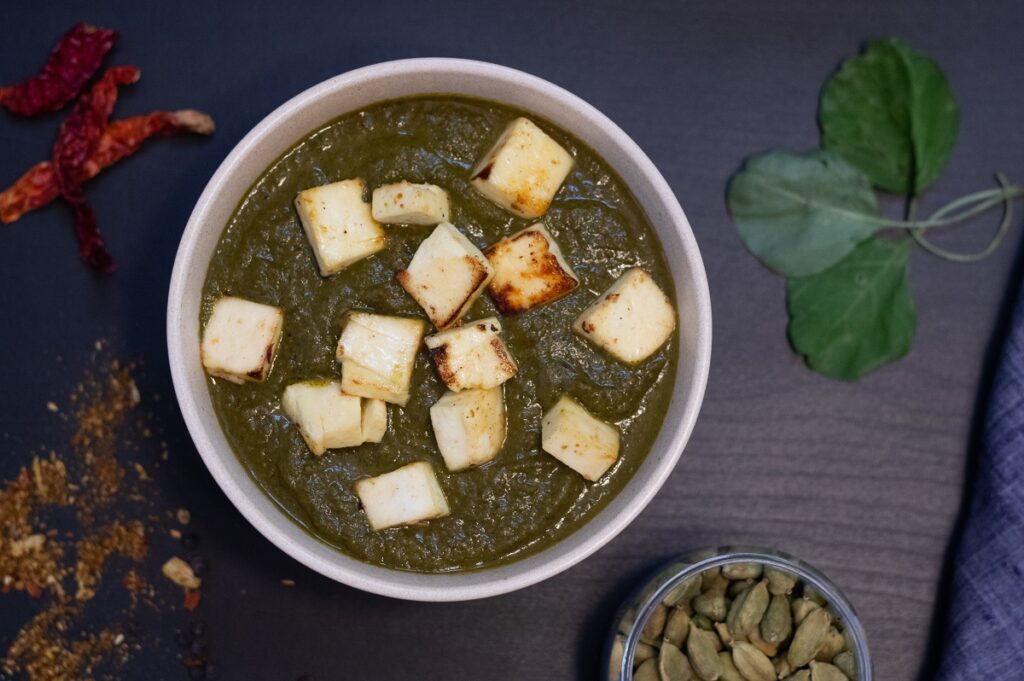
Bread and Rice
Indian cuisine boasts a diverse repertoire of bread and rice dishes that perfectly complement the rich flavors of the main course. The variety of Indian bread is a testament to the culinary heritage of the country. Naan, a soft and fluffy bread often cooked in a tandoor, is a popular choice to accompany curries and kebabs. Roti, a whole wheat bread, is a staple in many households and pairs well with a range of dishes. Paratha, a flaky and layered bread, offers a delightful indulgence with its buttery texture. These breads add a delightful element of texture and taste to the Indian dining experience.
When it comes to rice dishes, Indian cuisine showcases a symphony of flavors and aromas. Biryani is a fragrant rice dish layered with meat or vegetables. It is spiced with an array of aromatic spices, and garnished with nuts and raisins, and is a culinary masterpiece that is savored across the country. Pulao, a simpler rice dish cooked with a mix of vegetables, spices, and sometimes meat, offers a satisfying one-pot meal. Lemon rice, flavored with tangy lemon juice and tempered with spices. It is a refreshing and zesty rice dish that is often enjoyed as a standalone meal or as an accompaniment to other dishes. These rice delicacies highlight the versatility of rice as a base ingredient and showcase the art of Indian rice preparations.
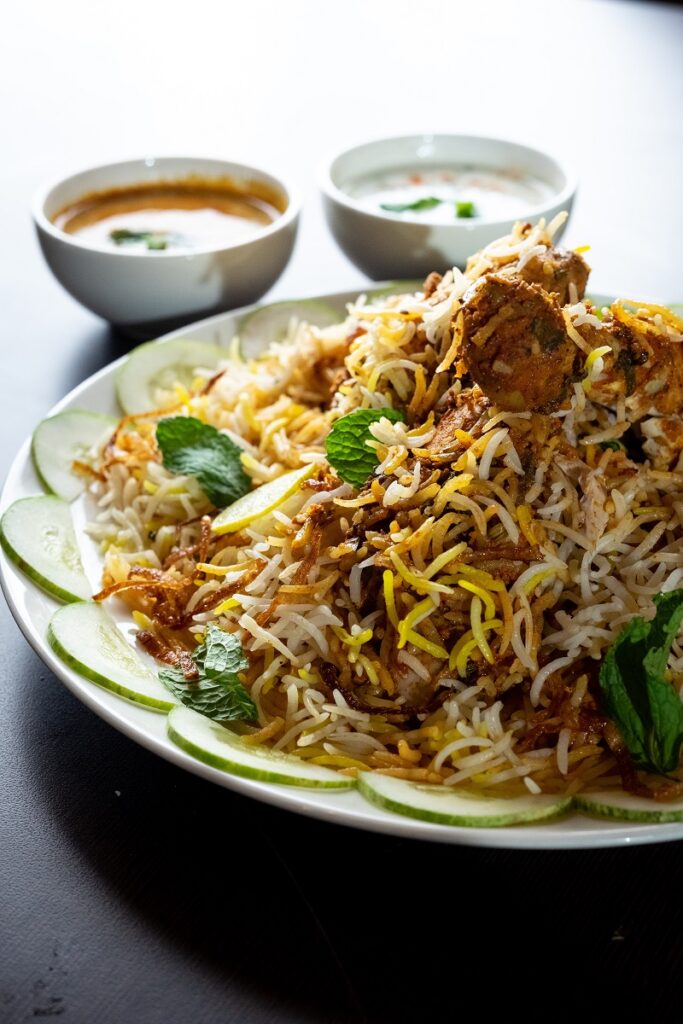
Desserts and Sweets
Indian cuisine is famous for its delectable array of desserts and sweets that offer a perfect ending to a memorable meal. Among the popular Indian desserts, gulab jamun takes the spotlight with its golden-fried dumplings soaked in fragrant syrup. While kheer, a creamy and aromatic rice pudding flavored with cardamom and garnished with nuts, provides a comforting and indulgent treat. Jalebi, a deep-fried pretzel-shaped sweet soaked in saffron syrup, is a favorite across the country.
Regional sweets further showcase the culinary diversity of India. Rasgulla, a popular Bengali sweet made of cottage cheese balls cooked in sugar syrup, embodies the delicate flavors of the East. Mysore pak, a rich and crumbly sweet from the South. Kulfi, a traditional Indian ice cream, offers a rich and creamy texture with flavors like cardamom, saffron, and pistachio, enticing the taste buds. These regional sweets capture the essence of their respective regions and reflect the cultural richness of India.
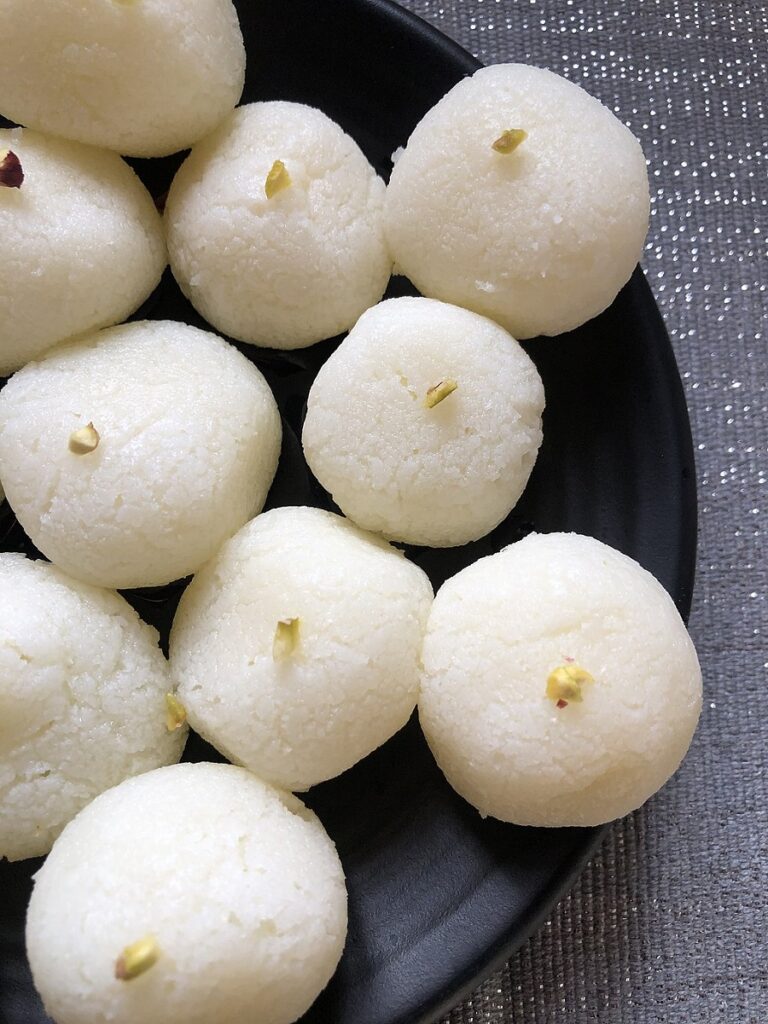
Dining Etiquette and Tips
Food holds immense significance in Indian culture, serving as a means of connection, celebration, and hospitality. It plays a central role in bringing people together and showcasing the warmth of Indian hospitality. Indian cuisine embodies the country’s rich traditions, flavors, and diversity, making it an integral part of cultural identity and social gatherings.
When dining in India, it is essential to be mindful of common dining customs and practices. Traditionally, many Indians eat with their hands, using their right hand for food consumption. Sharing meals with others is encouraged, as it promotes a sense of togetherness and community. It is customary to show respect for elders and guests by offering them food first. Additionally, removing one’s shoes before entering someone’s home or a temple is a common practice to maintain cleanliness and show respect.
To navigate Indian restaurants and order food effectively, a few tips can be helpful. Exploring diverse regional cuisines and trying local specialties can enhance the dining experience. Indian menus often feature a wide range of vegetarian options, so vegetarians will find ample choices. It’s also advisable to communicate any dietary restrictions or allergies to the restaurant staff, who can guide you in selecting suitable dishes. Lastly, if you’re unsure about the level of spiciness, you can ask for milder versions of dishes. Or request for condiments to adjust the spice level according to your preference.
Explore the tastes of India and indulge in a culinary adventure like no other!
Exploring the tastes of India is a fascinating journey through a culinary landscape that is as diverse as it is flavorful. From the rich and aromatic dishes of the North to the coastal delights of the East. And the vibrant flavors of the South and West, Indian cuisine offers a tapestry of tastes that captivate the senses.
With its extensive use of spices, a wide range of ingredients, and a deep-rooted connection to cultural traditions, Indian cuisine presents a unique and unforgettable gastronomic experience. Whether you’re savoring the buttery naan, indulging in a fragrant biryani, or relishing the sweetness of traditional desserts, each bite reveals the essence of India’s culinary heritage. So, embark on this culinary adventure, embrace the diverse flavors, and immerse yourself in the captivating world of Indian cuisine. A journey that promises to tantalize your taste buds and leave you with a deeper appreciation for the remarkable tastes of India.
